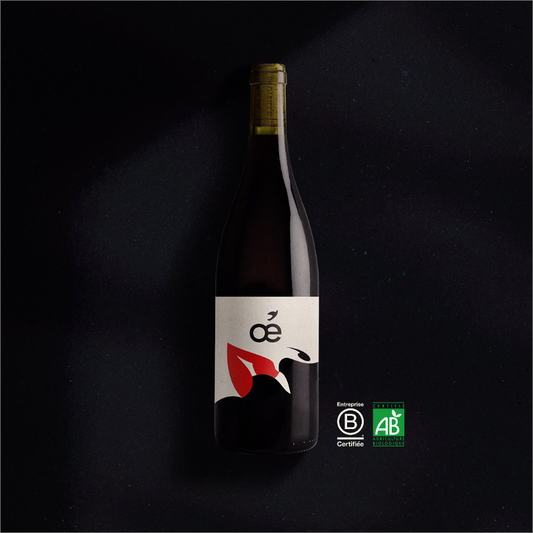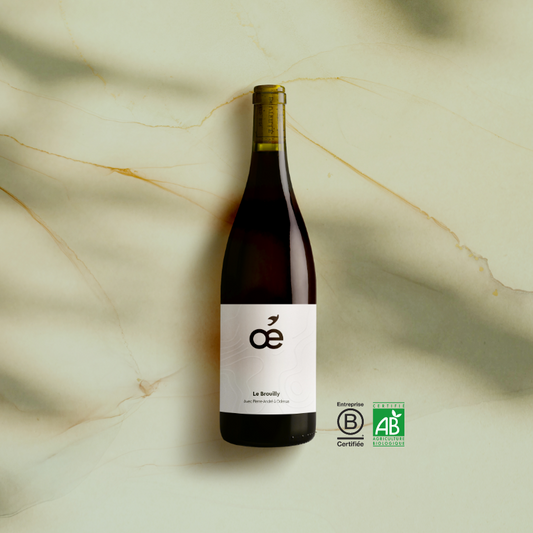At Oé, winegrowers are present in many vineyards in France in the towns of Pfaffenheim, Thénac, Pujols, Saint-Martin de Lapujade, Visan, Bollène, Ribaute… and many others. So today, we have chosen to introduce you to Marie-Paule, our winemaker Oé with whom we produce Le Corbières rosé , Le Languedoc red and Le Languedoc white . Let's go !
Marie-Paule, Oé winemaker and organic wine producer in Languedoc Roussillon
Marie-Paule is part of the sixth generation of the family on the estate. In addition to the vines that she has been farming organically for years, she cultivates many plants to make essential oils, herbal teas and floral waters. No no, she doesn't make potions like Panoramix, she just loves nature and the secrets that hide there! With our winegrower Marie-Paule , we travel in the middle of scrubland and crickets at each visit to her vineyards . This great lover of nature advises you to open the good organic wines with typical dishes of the region such as vegetable tians , roasted feta with candied lemons and olives or simply a good tomato-mozzarella . We are already salivating, how about you?
We tell you more about the three wine colors that we produce with Marie-Paule right here. Corbieres rosé :

The red Languedoc :


To find out more about Marie-Paule, here is a video we shot during one of our visits to the south of France in Ribaute.

The beautiful region of Languedoc Roussillon
The Languedoc Roussillon region is located in the south of France . Let 's go for a lightning lesson in geography! Today, the Languedoc-Roussillon region has been part of Occitanie since merging with the Midi-Pyrénées region . Languedoc -Roussillon is made up of five departments: Lozère , Gard , Hérault , Aude and Pyrénées Orientales . It includes the cities of Perpignan, Carcassonne, Narbonne, Béziers, Sète, Nîmes and Montpellier. So many cities where life is good. So far so good, and for those who have a rather visual memory, we offer you this zoom on the map of France!

The typicality of the Languedoc Roussillon terroir
The terroir of Languedoc is made up of a wide variety of soils : sandstone and marl, rolled pebbles, limestone, shale, clay, puddingstones, sand and basalts. We are in a mainly Mediterranean climate with hot and dry summers and very mild and sunny seasons. Rainfall is low and the thermometer very rarely drops below 0°C. Notice to the chilly, this region is made for you! The wind - called the tramuntana - is very present and helps to dry the humidity in the vines and on the plants and thus prevent diseases from developing. And that removes a major thorn in the side of our French winegrowers !
More and more wine estates in Languedoc conduct their operations in organic viticulture . To benefit from the AOC Languedoc appellation, a strict plot delimitation according to terroir criteria has been established. On these plots, we find the Carignan , Grenache noir , Syrah , Mourvèdre , Cinsault , Morastel , Picpoul noir and Terret noir grape varieties for red and rosé wines. For white wines, we are on white Carignan , white Grenache , Maccabeu , Bourboulenc , Marsanne , Roussanne , white Piquepoul , white Clairette , Rolle , Tourbat and Viognier .
The grape varieties of the vineyards must be from at least two grape varieties:
- For red wines and rosé wines , the wine must be composed of at least 50% Grenache noir, Syrah or Mourvèdre and 50% Cinsault and Carignan noir.
- For white wines , 70% of the grape varieties must be Grenache blanche, Clairette, Bourboulenc, Piquepoul, Marsanne and Roussanne, Rolle and Tourbat for 30% Carignan, Terret, Ugni, Maccabeu with a maximum of 10% Viognier.
In AOC Languedoc, the alcohol level must be greater than 11.5% and the vineyard must respect short-pruning rules, with a maximum of six coursons (the branches of the vines) with two eyes (the buds) per strain. The size is important because it will regulate the yield which must not exceed 50 hectoliters (= 5000 liters of wine) per hectare for red and rosé wines and 60 hectoliters per hectare for white wines.
Coteaux -du-Languedoc is an old wine with a controlled designation of origin . Since 2007, this appellation has been replaced by the Languedoc appellation .
Winemaking in Languedoc Roussillon
The vinification of Languedoc wines, whether IGP or AOC, is traditional. Some cuvées are still vinified according to the process of carbonic maceration , that is to say, with whole grains. During the grape harvest , the harvesting of the grapes is done by hand or with machines.
The red Languedoc offers an aromatic richness with its notes of ripe red fruits , spices and garrigue, the tannins are elegant and round. Our oenologist Valérie advises you to taste them with grilled meats or game such as lamb or rabbit or with good cheeses such as Pélardon or cooked cheeses.
The white Languedocs have lovely notes of white flowers and fruit. They are delicious with fish, oysters or even a good brandade. For rosé wines , generally vinified by bleeding or pressing, the winemaker controls the temperature at the start of fermentation and at the end of ageing. The color of the color varies according to the vinification: light pink or deep pink. They are excellent to discover with a tielle sétoise or a summer aperitif!
Organic wine producers in Languedoc
When you think of the Languedoc region , closing your eyes, it almost feels like it. The mistral blowing lightly, the cicadas singing and the warm smell of the scrubland. This is surely why organic wines feel so good there.
Languedoc-Roussillon is the wine region that produces the most organic wines with an area of more than 20,000 hectares of vines in organic farming . This represents a third of the organic vineyard . Each year, the Millésime Bio fair in Montpellier offers wines from a large number of winegrowers who work to preserve biodiversity. Some winegrowers have chosen to go further than organic winemaking by producing biodynamic wines , natural wines , natural wine , without sulphur , without chemical inputs and without additives . Cannon, right?
Languedoc wines are very popular abroad thanks to their typicality. We told you about it above, the grapes soaked in heat and sun give the wine a charm that is very pleasing. The charms of the south, what do you want! Exports of Languedoc wine to the world represent a third of the production of French wines each year.
We invite you to learn more about the beautiful regions of France in our articles on the wines of Provence , Wines of the South , Côtes du Roussillon , Côtes-de-Provence and to discover the wines of Côtes-du-Rhône , Bordeaux , Vaucluse , and the Mediterranean.





